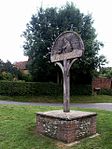Marlingford
AC with 0 elementsFormer civil parishes in NorfolkSouth NorfolkVillages in Norfolk

Marlingford is a village and former civil parish, 6 miles (9.7 km) west of Norwich, now in the parish of Marlingford and Colton, in the South Norfolk district, in the county of Norfolk, England. In 1931 the parish had a population of 181.
Excerpt from the Wikipedia article Marlingford (License: CC BY-SA 3.0, Authors, Images).Marlingford
Barford Road, South Norfolk Marlingford and Colton
Geographical coordinates (GPS) Address Nearby Places Show on map
Geographical coordinates (GPS)
| Latitude | Longitude |
|---|---|
| N 52.638377 ° | E 1.1484501 ° |
Address
Barford Road
Barford Road
NR9 5HX South Norfolk, Marlingford and Colton
England, United Kingdom
Open on Google Maps









